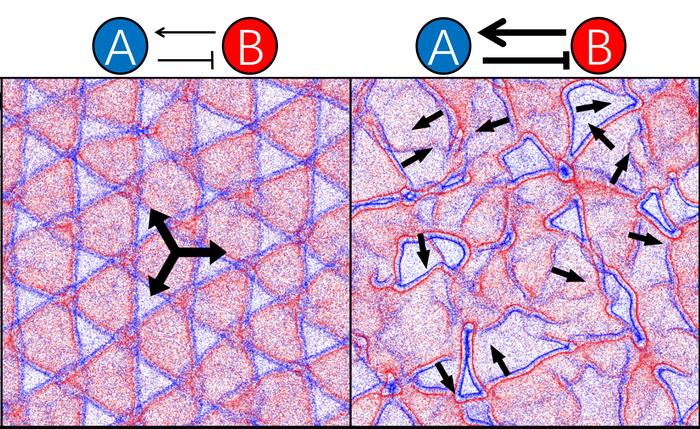In a recent study, scientists from the department Living Matter Physics at MPI-DS developed a model describing communication pathways in bacterial populations. Bacteria show an overall organizational pattern by sensing the concentration of chemicals in their environment and adapting their motion.

Credit: MPI-DS / LMP
In a recent study, scientists from the department Living Matter Physics at MPI-DS developed a model describing communication pathways in bacterial populations. Bacteria show an overall organizational pattern by sensing the concentration of chemicals in their environment and adapting their motion.
The structure only becomes visible on a higher level
“We modeled the non-reciprocal interaction between two bacterial species”, first author Yu Duan explains. “This means that species A is chasing species B, whereas B is aiming to repel from A”, he continues. The researchers found, that just this chase-and-avoid interaction is sufficient to form a structural pattern. The type of the resulting pattern depends on the strength of the interaction. This complements a previous study, where a model was proposed that also included intraspecies interactions of the bacteria in order to form a pattern.
In this new model, which also includes the effect of bacterial motility, neither adhesion nor alignment are required to form complex super-structures encompassing millions of individuals. “Although the bacterial population dynamics show a global order, this is not the case on the individual bacterial level. In particular, a single bacterium seems to move in a disordered way, with the structure becoming visible only on a higher level, which is very fascinating”, summarizes Benoît Mahault, group leader in the department Living Matter Physics at MPI-DS.
A general model for collective behavior
The model also allows to consider more than two species, increasing the amount of possible interactions and emerging patterns. Notably, it is also not limited to bacteria but can be applied to a variety of collective behaviors. These include light-controlled microswimmers, social insects, animal groups and robotic swarms. The study therefore provides general insights on the mechanisms responsible for the formation of large-scale structures in networks with many components.
Journal
Physical Review Letters
DOI
10.1103/PhysRevLett.131.148301
Method of Research
Computational simulation/modeling
Subject of Research
Cells
Article Title
Dynamical Pattern Formation without Self-Attraction in Quorum-Sensing Active Matter: The Interplay between Nonreciprocity and Motility
Article Publication Date
3-Oct-2023




